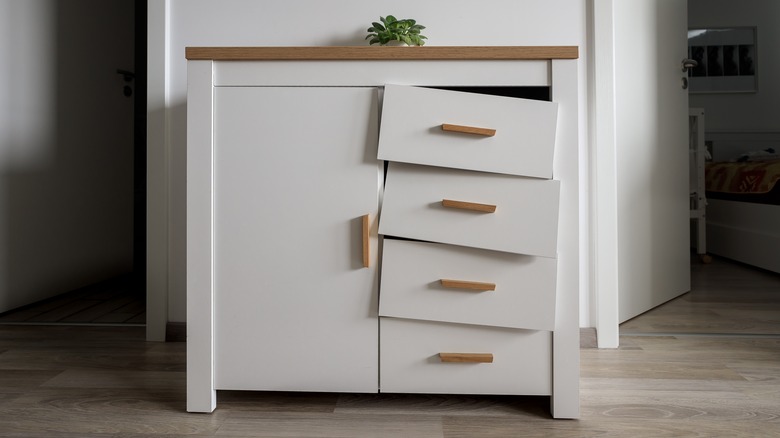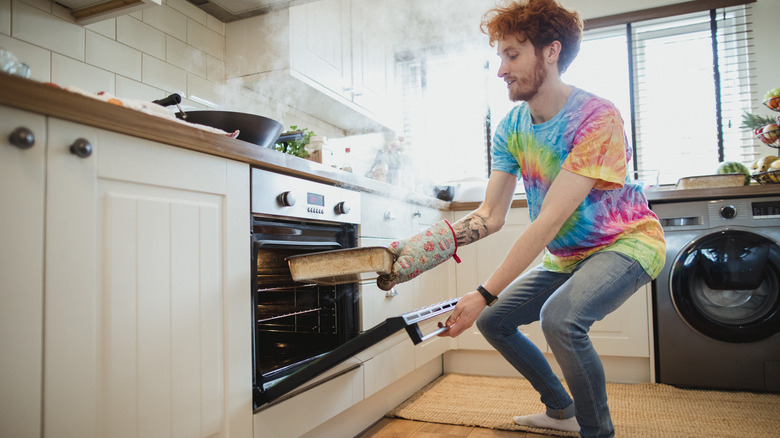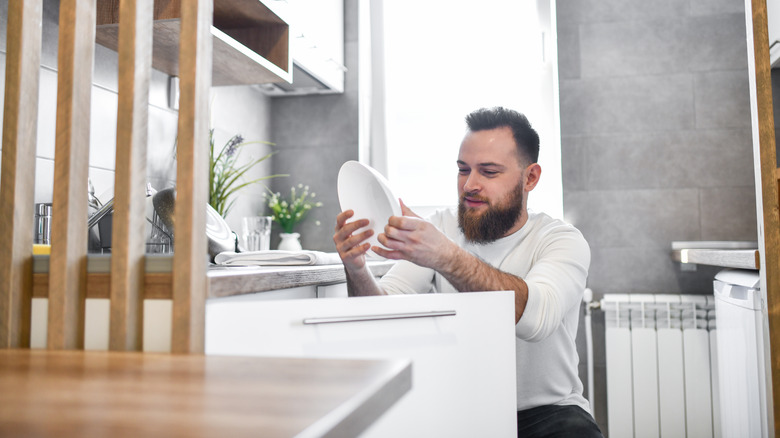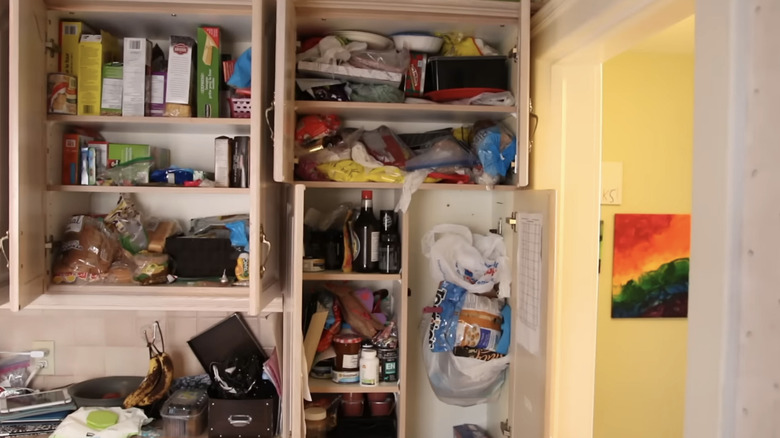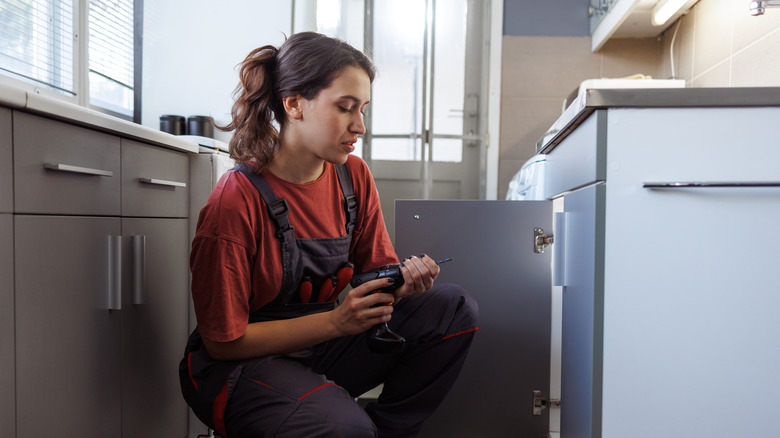Ways You're Damaging Your Cabinets Without Even Noticing
Cabinets are a necessary part of any functional kitchen, holding all of our cooking essentials, table decor, dishes, and sometimes anything and everything that doesn't have a proper house in your home. They also happen to be one of the most expensive parts of any kitchen to install and repair, which is why maintaining them is important for any renter or homeowner.
Of course you probably know not to slam the doors shut, or load a bunch of soggy wet towels onto the shelves. Some of the ways you may be damaging those cupboards and cabinets can involve not paying enough attention to what you're putting in them, whether you're loading dirty dishes in or overstuffing them. You also may be exposing your cabinets to steam, smoke, and heat, as well as debris and grease buildup, which might not be an issue once or twice but can cause huge issues down the road.
And just like you don't want to neglect regular cleaning, you also don't want to ignore small repairs your cabinets need, even if that hinge only seems a little bit loose at the moment. But there are some simple mistakes you may be making that can damage your cabinets, and if you continue those practices over time or ignore them, the results can be costly. That's why it's key to know the ways you might be inadvertently damaging your cabinets so you can make sure they stay in good shape for years to come.
Cooking without the fan on
When you're cooking in the kitchen and there are a million noises going on — the stove timer going off, the clanging of pots and pans — the last thing you want to do is turn your stove hood's fan on. But it's imperative that you do because failing to do so can mean major issues for your cabinetry. Stove exhaust fans work to eliminate water, grease, and smoke from the air. Without turning the fan on, these substances will float and lock onto nearby surfaces, including your cabinets.
In the short term, the water and grease can become sticky, which attracts dust, hair, and dirt, making your cabinets dirty and unsanitary. This also makes them difficult to clean. In the long term, water damage from the steam as well as smoke damage can discolor and deteriorate your cabinets' finish. The fan also mitigates extreme temperature fluctuation and humidity, which cabinets, especially those made of wood (a common cabinet material), are extremely sensitive to. Prolonged heat exposure can warp the shape of the cabinets, cause cracking, weaken their joints, and more.
To prevent this, turn your kitchen exhaust fan on before you start cooking no matter what you're preparing. Be sure to use it at the highest possible setting to most efficiently remove pollutants from the air, thereby protecting your cabinets from them. You should also always turn your exhaust fan on in your bathroom whenever you shower to prevent paint or cabinet damage.
Forgetting to check your dishes for food and water
Nobody wants to spend time examining their dishes after they pull them off of the drying rack or open the dishwasher door in the morning, but it's an important step to preventing issues in your cabinets. Dishes can easily get loaded into the cabinets and cupboards before they're fully clean or dry. This might seem pretty harmless but can cause major issues given enough time.
Food particles can attract all manner of pests into your cabinets, including rodents. Not only does this cause food safety issues for you and your family, but the presence of pests can harm your cabinets. Rodents like mice and rats have a tendency to cozy up inside cabinets, and may even chew through them, which is unsightly, unsanitary, and harms their structural integrity.
Damp dishes also attract unwanted visitors such as silverfish, which can eat their way through lots of things, including glue. Yes, glue, like perhaps the wood glue that's holding your cabinets together. Additionally, the dampness can lead to mold, which breaks down surface materials as it grows, weakening it over time. If left long enough, it can eat through most any porous material such as wood, particleboard, and even the drywall behind your cabinets. The solve for this issue is simple — always give your dishes a once-over and wipe away any food particles or moisture away with a clean dish cloth before you put them in the cabinet.
Overloading your shelves
One of the best things about cabinets is that they have doors. Behind those doors, you can stash away lots of heavy pots and pans, mismatched dinner plates and platters, and all the other miscellaneous serving ware you never need except at the holidays. Only issue? If all of these are stacked up in the cabinet, they may be too heavy and threaten the structural integrity of the shelves, hinges, and doorframes. One easy way to tell if this is an issue is if you notice the cabinet shelves are beginning to sag, or if the cabinet door always slams into the handles of the pots and pans when you try closing it. If left unaddressed, the shelf can break irreparably, and the cabinet door can get worn down.
If you can, try not to store all of your heavy items on the same shelf in the same cabinet, and reorganize to ensure the cabinet doors can close easily. If you're lacking storage space, there are some solutions as well. Avoid storing heavy pots and pans in the middle of the shelf to prevent bowing, and don't stack heavy pots and pans on top of each other because they can quickly become too heavy. You can also try to install a cabinet organizing system even with limited space, like a bar to hang some pans from, or a lazy Susan to reduce the pressure of the pans, all while making the cabinet more easily accessible.
Not tackling repairs proactively
Have you noticed a squeaky hinge on one of your cabinet doors? Or some paint peeling in the back of another? It's time to hop on that, and quickly. Neglecting small, simple repairs in your cabinets can lead to larger issues down the road. A squeaky hinge can be a sign of something relatively benign, like the need for a little lubricant. Or, it may be more serious, like a symptom of poor installation that has caused the wood of the door and the cabinet frame to scrape against each other. The peeling paint can be a sign of water damage which, as stated above, can lead to mold and wood warping.
So instead of just ignoring these little nuisances, take care of them before they become a bigger issue. Do what you can on your own, like applying WD-40 Silicone Lubricant to squeaky hinges, or repairing and repainting the peeling paint, for example. If the issue resolves itself, great, but if not, you may want to call a handyperson over to take a look and work their magic. Even though this can get pricey, it's less expensive than having to replace the cabinets entirely and much better for their longevity.
